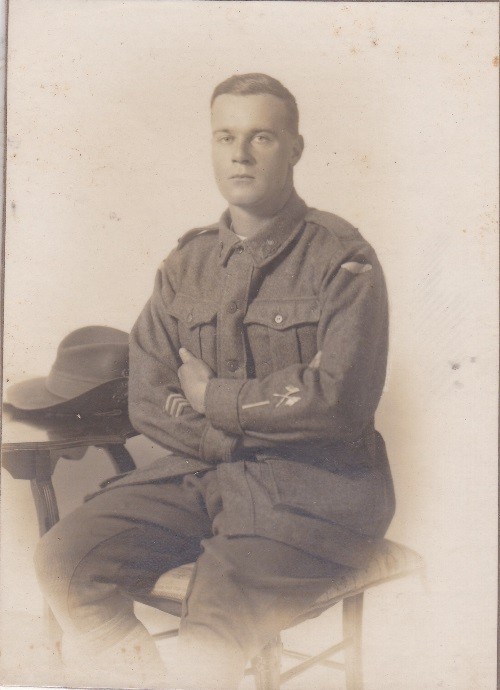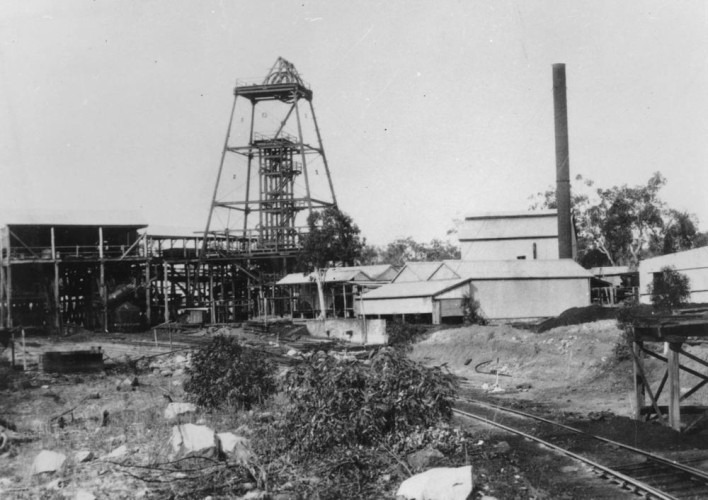Digitised@SLQ: Signaller Charles William Arthur Johnston Diary
By JOL Admin | 28 April 2017

Signaller Charles William Arthur Johnston, ca. 1916. Source: family photograph.
The State Library has recently digitised an interesting World War I diary kept by Signaller Charles William Arthur Johnstone of the 41st Battalion. The diary covers the period December 1916 to August 1919, beginning with the train journey from Rifle Range Training Camp in Brisbane, the voyage to England where he was trained as a signaller, service on the Western Front, and the voyage back to Australia in mid 1919.
Arthur Johnston, as he was known, was born in Clermont in Central Queensland in 1894, being the only son of Charles Alexander Johnston from Birmingham, England, and Amelia Preston from Glasgow, Scotland. His parents migrated separately to Queensland and met and married in Clermont. The couple had three children; Herbert William Henry born in 1882 who sadly died as a infant, Beatrice Mary born in 1886, and Arthur.
After working as a miner in Clermont and Blair Athol, Arthur enlisted on 3rd October 1916 at the age of 21. He was assigned to the 41st Infantry Battalion, 6th Reinforcement, and embarked on the troopship Demosthenes from Sydney on 23rd December. After training in England and completing an instruction course as a signaller Arthur joined the 41st Battalion in France in October 1917.

Certificate from the Signallers' School in England. Source: family collection.
Arthur was involved in heavy fighting on the Somme and was wounded in action with gas poisoning on May 24th 1918 which caused him to go blind for several days. He describes this incident in his diary:
May 20th. This night our brigade took over a section in the front line, known as 'Villers Brettoneaux' sector. Going into the line that night we were bombed and shelled, for the last 2 ½ miles of the road up. Quite a number were wounded & killed. This time in the line, I was a 'Linesman', & my friend & I had rather a rough spin, as our wires were always getting broken. But things were not so bad until the Saturday night, May 24th, when at 6pm this night the Hun shelled with gas until 2pm, on the Sunday afternoon. This night, my friend & I were out & up till midday on the Sunday when we both went to the R.A.P. & were both sent away, the both of us just about blind from the effects of the gas in our eyes. We both landed at the 49th C.C.S. at midnight, & neither of us could see at all then. Anyway after 5 days of blindness I began to see a little, then I lost my voice for 4 days & also a large burn came out on my hip which was not very nice. After remaining here for 13 days I was discharged from Hospital & sent along to the Divisional wing where we stayed another 5 days. (Arthur Johnston Diary, p. 31- 32)
After returning to his battalion he was involved in battles at Hamel and Mericourt in France, before participating in the major allied push which broke the Hindenburg Line in September and October 1918. Arthur writes of this difficult time:
The next morning (29th) at day break we set out for the front line, but this time we had American troops to break the 'Hindenburg Line', while the Australian troops had to pass through the Americans, when they had reached their objective, but neither of the troops reached their proper objectives. On account of the enemy having so many dugouts & tunnels in this line, there were more of the enemy left to fight the Australians than there were when the Americans advanced & with our tanks the most of them being blown up with mines, the Americans were cut off, & the Australians could not advance to help them. All units here suffered very heavily as men were laying in almost every shell hole, & after 5 days of the hardest fighting of the lot for that year we had not advanced much more than 3000 yards. Very few prisoners were taken here for almost every man fought to the last & none of them had any mercy from us. This was the worst battle I was in. I had a few very narrow escapes & when my own unit was relieved from here we marched back to Doingt with 127 men, our own casualties in the 'Hindenburg Line' being almost 500. To make things worse it was raining the whole 5 days. (Arthur Johnston Diary, p. 44-45)

41st Battalion signallers preparing a meal near Sailly-le-Sec, France, 28 March 1918. Arthur Johnston is standing, far right. Source: Australian War Memorial, ID No. E01869.

Studio portrait of Arthur Johnson, ca. 1917. Source: family photograph.
After the war Arthur spent time in England before returning to Australia in June 1919. He was offered an instructional post with the army but instead returned to his work as a miner at Blair Athol in Central Queensland. At a welcome home dance for returned soldiers in Clermont he met Adelaide Edna Marsson, whom he married in January 1920. The couple had 3 daughters and 3 sons. Sadly their eldest daughter, Edna May, died of meningitis in 1932, aged 11.
In 1924 the family moved to the new mining settlement of Collinsville where Arthur was employed at the State Mine until his retirement in 1943.

Collinsville State Mine, ca. 1930. Source: John Oxley Library, Negative No. 27192.
They then moved to Bowen where Arthur ran a fruit delivery service and later a bottle collection business. He was a long-time member of the Returned Services League and served during World War II with the Citizen Military Forces. Arthur died at the Bowen Hospital on the 19th July 1974 at the age of 79.
We are very grateful to the descendants of Arthur Johnston who very generously donated this precious family diary to the John Oxley Library. The diary, accession no. 30741, is available online or in the John Oxley Library Reading Room.
Lynn Meyers, Original Materials Librarian
Comments
Your email address will not be published.
We welcome relevant, respectful comments.